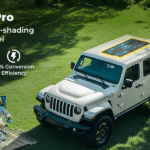The vehicle-based camping market has experienced explosive growth with roof top tents becoming increasingly popular among weekend adventurers and serious overlanders alike. For those looking to find the best roof top tents suited to their specific travel style, vehicle type, and environmental conditions, navigating the complex marketplace requires systematic evaluation across multiple technical and practical dimensions. This specialized camping equipment represents a significant investment that directly impacts both travel comfort and vehicle performance, making informed selection critical to adventure satisfaction. A methodical approach to assessment helps identify the optimal balance between conflicting priorities including weight, packed size, deployment complexity, and weather protection capability.
Assess Your Vehicle’s Specific Carrying Capacity
The foundation of appropriate roof top tent selection begins with precise vehicle compatibility assessment:
Locate your vehicle’s dynamic roof load rating in the owner’s manual or manufacturer specifications. This figure—typically ranging from 110-220 pounds for most SUVs and 75-165 pounds for passenger cars—represents the maximum weight safely carried while the vehicle is in motion. This specification differs significantly from static load capacity and serves as your primary constraint.
Calculate your effective capacity by subtracting the weight of your roof rack system from the dynamic load rating. Quality aluminum rack systems typically weigh 20-40 pounds, while steel systems can exceed 60 pounds, substantially reducing available capacity for the tent itself.
Measure your roof rack’s actual load bars rather than relying on manufacturer length specifications. The effective mounting surface often measures 4-6 inches less than the nominal rack width due to end cap design and edge compatibility limitations. This measurement determines the maximum tent base dimensions your vehicle can properly support.

Evaluate Your Deployment Frequency Requirements
Your anticipated usage pattern significantly influences appropriate mechanical system selection:
For frequent deployment scenarios (setting up/breaking camp daily), prioritize systems utilizing gas strut assistance with single-motion opening mechanisms. These designs typically deploy in under 90 seconds when properly maintained but carry weight penalties of 15-25 pounds compared to manual alternatives.
For extended-stay scenarios with infrequent relocation, consider manual deployment systems that sacrifice convenience for reduced weight and mechanical complexity. These designs typically require 4-7 minutes for complete setup but offer worthwhile weight reduction for vehicles with limited carrying capacity.
For mixed-use scenarios, evaluate hybrid systems that incorporate partial assistance mechanisms. These designs typically employ spring-tensioned supports rather than gas struts, offering compromise performance with reduced weight penalties compared to fully-assisted alternatives.

Match Design Architecture to Environmental Conditions
Tent architecture must align with your anticipated environmental exposure:
For predominantly warm-weather use, prioritize designs emphasizing ventilation through multiple mesh panels, cross-flow ventilation architecture, and reduced insulation. These features maximize nighttime cooling but sacrifice cold-weather performance and noise isolation.
For cold-weather applications, focus on insulation factors including thicker canopy materials (300g+), reduced mesh exposure, and optional seasonal panels that allow environment-specific configuration. These features typically add 15-20% to base weight but dramatically extend comfortable usage temperature ranges.
For high-precipitation environments, evaluate specific water management features beyond simple waterproof ratings. Effective designs incorporate extended rain flies, seam-sealed construction, and elevated entry points that prevent water channeling into living spaces during entry/exit.

Consider Interior Space Utilization
The functional interior space often differs significantly from marketed dimensions:
Measure interior height at sleeping surface rather than maximum height, as this dimension determines actual usable space when occupying the tent. Effective designs maintain minimum 30-inch clearance across at least 60% of the sleeping platform rather than only at the center peak.
Evaluate the sleeping surface dimensions against your specific requirements rather than generic capacity ratings. “Two-person” designations vary dramatically between manufacturers, with sleeping platforms ranging from 43 inches to 55 inches in width—a critical difference for actual comfort.
Consider the orientation of support poles and interior structures that may intrude into usable space. Some designs maximize interior volume by positioning support structures at the perimeter, while others sacrifice usable space for structural efficiency with cross-bracing that intrudes into the sleeping area.

Analyze Setup Complexity Under Varied Conditions
The practicality of field deployment significantly impacts real-world satisfaction:
Evaluate the number of separate user actions required for complete deployment, particularly focusing on steps requiring precise alignment or significant force application. Quality designs minimize these requirements through self-aligning components and mechanical advantage systems that reduce necessary force inputs.
Consider setup requirements under adverse conditions including darkness, precipitation, and wind. Premium designs incorporate high-visibility indicators for proper sequencing, protected setup mechanisms that prevent water intrusion during deployment, and intermediate securing points that maintain stability during multi-stage setup.
Assess one-person setup practicality by examining the positioning requirements during critical deployment phases. Effective designs allow single-operator setup without requiring simultaneous actions at opposite ends of the tent or strength-intensive maneuvers that exceed average user capabilities.






